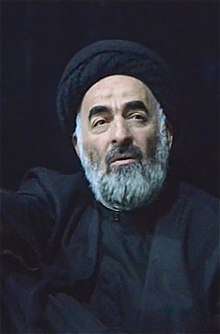Ali Akbar al-Modarresi
Ayatollah Sayyid Ali-Akbar al-Husayni al-Modarresi (Persian: على أكبر حسينى مدرسى; Arabic: علي أكبر الحسيني المدرسي; b. 17 September 1957) is a Shia Iranian-Iraqi scholar and teacher.[1]
Ali-Akbar al-Modarresi | |
|---|---|
السيد علي أكبر الحسيني المدرسي | |
 | |
| Personal | |
| Born | September 17, 1957 |
| Religion | Islam |
| Nationality | Iranian |
| Children | Muhammed-Ridha |
| Parents | Mohammed Kadhim al-Modarresi (father) |
| Denomination | Twelver Shīʿā |
| Relatives | Mirza Mahdi al-Shirazi (grandfather) Mohammad Taqi al-Modarresi (brother)[1] Hadi al-Modarresi (brother)[1] Muhammad al-Shirazi (maternal uncle)[2] Abd al-A'la al-Sabziwari (uncle-in-law)[3] |
| Senior posting | |
Students
| |
Family
al-Modarresi was born into a distinguished Shia religious family in Karbala in Iraq. His father is Ayatollah Sayyid Muhammad-Kadhim al-Modarresi,[1] the grandson of grand Ayatollah Sayyid Muhammad-Baqir Golpayegani (also known as Jorfadiqani).[4] His mother is the daughter of grand Ayatollah Sayyid Mehdi al-Shirazi. He claims descent from Zayd ibn Ali (died c. 740 AD), the great-great-grandson of the Islamic prophet, Muhammad.[5]
Religious career
al-Modarresi studied in the religious seminaries of Karbala, under his father, Sayyid Muhammad-Kadhim and brother Sayyid Muhammad-Taqi, as well as senior scholars such as Shaykh Muhammad-Husayn al-Mazindarani, Shaykh Jafar al-Rushti, and his maternal uncles Sayyid Muhammad al-Shirazi and Sayyid Hassan al-Shirazi.[5] He emigrated to Kuwait with his older brothers in 1971, due to the Bathists anti-Shia sentiment.[6][7] They settled there until 1979, after which they moved to Iran after the Islamic Revolution.[8]
al-Modarresi taught in al-Qaim seminary, which was established by his brother Muhammad-Taqi, in 1980, until it was closed down in 1990. He remained in Tehran whilst his brothers went to Syria,[9] teaching in different religious seminaries, until he moved to Mashhad in 2014, and began teaching at its seminary, near the shrine of Imam al-Ridha.
During his time in al-Qaim, al-Modarresi taught distinguished Saudi activist Nimr al-Nimr and was considered as his mentor. He had a close relationship with him even after the closure of the seminary, until his execution in 2016.[10][11]
Personal life
al-Modarresi is married to the daughter of prominent scholar, Baqir al-Qazwini (d. 1974).[12]
References
- al-Muhtadi, Abd al-Atheem (2009). Qusas Wa Khawatir - Min Akhlaqiyat 'Ulama' al-Din [Stories and Memories - From the Manners of the Scholars]. Beirut, Lebanon: Mu'asasat al-Balagh. p. 581.
- Louër, Laurence (2011). Transnational Shia Politics: Religious and Political Networks in the Gulf. Hurst. p. 93. ISBN 978-1-84904-214-7.
- al-Muhtadi, Abd al-Atheem (2009). Qusas Wa Khawatir - Min Akhlaqiyat 'Ulama' al-Din [Stories and Memories - From the Manners of the Scholars]. Beirut, Lebanon: Mu'asasat al-Balagh. p. 345.
- al-Tehrani, Agha Buzurg (2009). Tabaqat A'lam al-Shia; al-Kiram al-Barara Fi al-Qarn al-Thalith Ashar [Levels of the Notables of the Shia (13th Century)]. 10. Cairo, Egpyt: Dar Ihya' al-Turath al-Arabi. p. 165.
- Ṭuʻmah, Salmān Hādī (1998). Asha'er Karbala Wa 'Usariha [Tribes and Families of Karbala] (in Arabic). Beirut, Lebanon: Dar al-Mahaja al-Baydha'. pp. 197–8.
- "Saddam Hussein's legacy of sectarian division in Iraq". Public Radio International. Retrieved 2020-01-15.
- "Iraq's Oppressed Majority". Smithsonian Magazine. Retrieved 2020-01-15.
- al-Jibouri, Kamil Salman (2003). Mu'jam al-'Udaba' Min 'Asr al-Jahili Hata Sanat 2002 [Glossary of Scholars: From the Jahiliyyah to 2002 AD] (in Arabic). 5. Beirut, Lebanon: Daar al-Kitab al-'Ilmiya. pp. 180–1.
- al-Lobad, Adil (2009). al-Inqilab, Bay' al-Qiyam 'Alal Thaat [Coups, Selling Morals For Ego] (in Arabic). Laila for Publishing & Distributing. pp. 339–40.
- "al-Shaykh al-Nimr Shaheedan" [Shaykh Nimr is a martyr]. Imam Khomeini Cultural Foundation (in Arabic). Retrieved 2020-03-16.
- al-Modarresi, al-Sayyid Mehdi (2017-01-13). "أستاذ الحوزة العلمية المقدسة سماحة آية الله السيد علي أكبر المدرسي، ليس شخصية إعلامية، لكن يكفيه فضلاً أنه أحد أساتذة آية الله #الشهيد_النمرpic.twitter.com/TeaxSKVjzc" [Teacher at the holy seminary, Ayatollah Sayyid Ali Akbar al-Modarresi, is not a media personality, but it is enough that he was one of the teachers of the martyr Ayatollah Nimr]. @TheSayed (in Arabic). Retrieved 2020-03-16.
- Ṭuʻmah, Salmān Hādī (2009). Mashahir al-Madfunin Fi Karbala [Famous Figures Buried In Karbala] (in Arabic). Beirut, Lebanon: Dar al-Safwa. p. 109.CS1 maint: date and year (link)